SUMMARY
This is AI generated summarization, which may have errors. For context, always refer to the full article.
![[Ilonggo Notes] Oh, those hearty Ilonggo soups!](https://www.rappler.com/tachyon/2022/06/Those-hearty-Ilonggo-soups.jpg)
The Ilonggo-speaking provinces of Panay and Negros Islands, mainly the provinces of Iloilo and Negros Occidental, are blessed with an abundance of natural resources. Panay was so named by the Spanish – pan hay or “there is bread” – after they reached the island in the 1560s, abandoning a Cebu hit by famine. The region has a distinctive cuisine, ranging from soups to salads to pastries and desserts, which has benefited from influences from China, Spain, and Mexico.
Oton town was one of the earliest settled areas of the country, known for shipbuilding. It was a transit point for the galleon trade and forays into the Moluccas. It is not inconceivable that culinary and cultural influences from across the seas arrived via these routes. Molo, being the Parian (Chinese quarters), would have a significant Chinese and mestizo community. Ilonggo food writer and historian Doreen Fernandez notes that Pinoys learned to sauté from the Chinese and stew from the Spanish; before that, grilling or boiling were the main methods used for cooking.
What food then is most associated with the Panay-Negros region? Arguably it must be the eponymous dishes such as Lapaz Batchoy, Pancit Molo, Panaderia de Molo, Bacolod Inasal and Piaya, Puto Manapla, Barquillos de Iloilo, Biscocho de Jaro, Pavia’s Baye-Baye, etc.
But let’s concentrate on the hearty soups of Ilonggo origin, the ones that set one’s juices racing, taste buds stirring, and sweat beading. Several of the dishes are named after Ilonggo ways of cooking, or after Ilonggo terms.
The most popular, in my opinion, would be Lapaz Batchoy. Depending on who your source is, this was said to have been first concocted in the Lapaz public market, or may have been adapted from a Chinese dish called “bas-oy.” Steaming egg noodles (miki), and an earthy broth of beef and pork stock (some add chicken stock and a dash of ginamos, the Ilonggo shrimp paste) with beef and pork entrails are the major ingredients. The dish is topped with pork crackling, chives or green onion leaves, and toasted garlic. It can be eaten any time of the day and is said to be better in the afternoons when the flavors have settled.
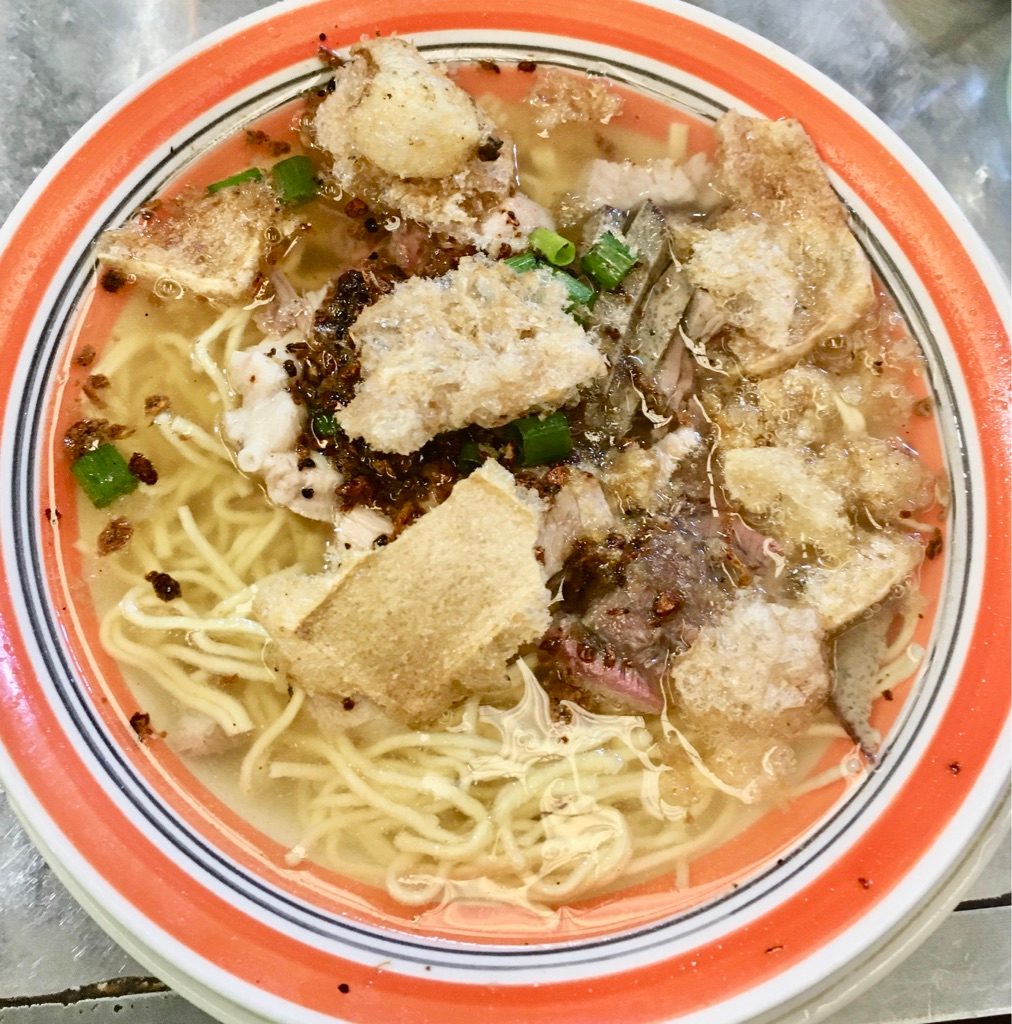
Nowadays, variants have sprung up – for example, using different types of noodles, such as miswa, or sotanghon. Some have tried combinations with buko (coconut) strips, bulalo, and pata, thus “buko batchoy,” “bulachoy,” and “patachoy,” none of which appeal to me as a batchoy purist. Several Iloilo batchoyans have become household names – Deco’s, Netong’s, Alicia, Popoy’s, Inggo’s, Jasmine, Ted’s. Batchoy is usually served with puto or pandesal, and the caldo (broth) is refillable. It comes in varying sizes: ordinary/regular, special, mega, etc., with some variations on volume and toppings, which can also include egg and bone marrow.
Next up is Pancit Molo – this is something my mum and aunts used to make, and no house in Molo would be worth its salt if it didn’t have a recipe for it. Ground pork would be seasoned with salt, pepper, lots of minced garlic, onions, and chives, then about half a teaspoon of the mixture would be wrapped in a flat, freshly prepared noodle sheet (the pancit), and rolled into something resembling a nun’s wimple. Thus, it is similar to wantons, though wrapped up differently. After air drying, these would be simmered in a chicken broth, with bits of chicken meat. Sometimes shrimp stock will be added, too. Topped off with chives, it is delicious served with biscocho.
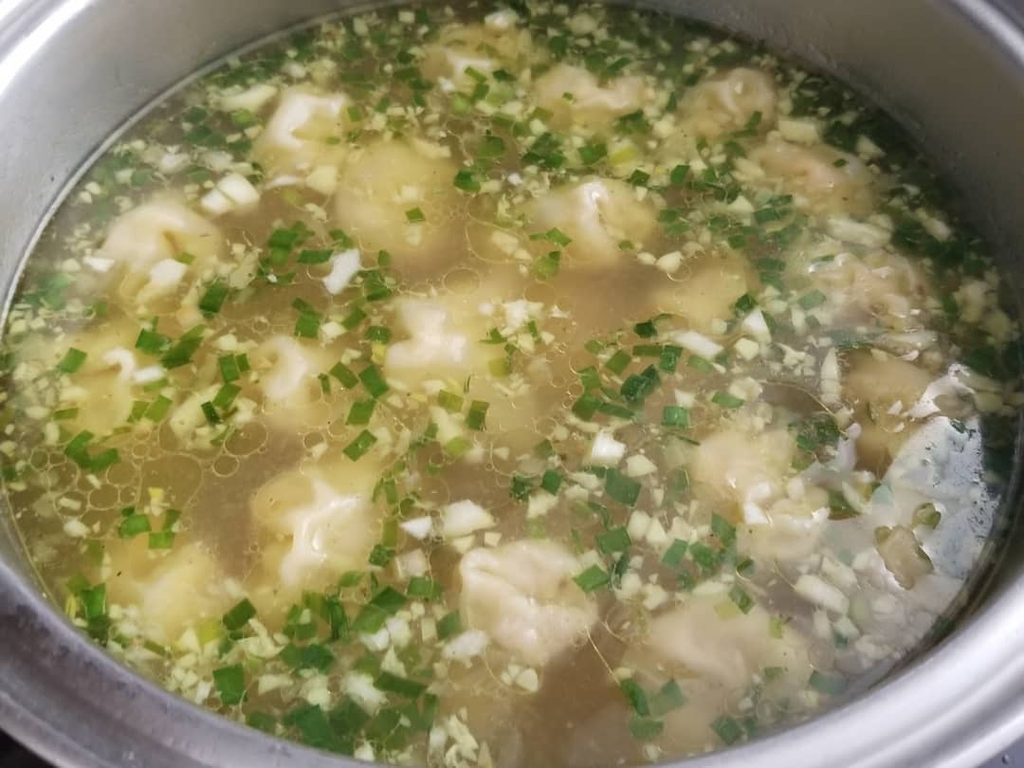
When we were kids, the fresh noodle sheets, which would be ordered from a “manog-ligis” (noodle maker) neighbor who was known for the best ones, were easily stretchable, sufficiently thin, and never brittle. We used to help roll the balls — and once played a trick on an unsuspecting cousin, filling one of the balls with no meat, only chives and garlic, and we laughed when we saw his facial expression as he bit into it. Luckily it did not go to one of the invited guests! Nowadays, Pancit Molo balls are less commonly made at home, as frozen Molo balls are now available in supermarkets. We are partial to those made by a relative who lives a few blocks away – “Kap Ising” has been featured on celebrity shows with Kris A. and Korina S. The balls can be frozen for up to two weeks. We make our own stock and just cook the balls in them when we wish.

Philippine sour soups such as sinigang also have Ilonggo versions, but the souring agents used, such as batwan fruit (garcinia binucao) and libas (Spondias pinnata) leaves, are indigenous to the region. Nilagang baka (slow boiled beef soup) has an Ilonggo version too, generically known as lina-ga. One version is known as kansi, originally of Negros Island. Various beef cuts are soured with batwan, which has a subtler taste than tamarind. For this, Pat-Pat’s kansi is the place to go to in Iloilo. The main restaurant in Jaro is in a beautifully restored heritage house, and there are branches in Manila.

Chicken Binakol originated in Aklan, one of the provinces in Panay. Here native chicken (darag na manok) pieces are sautéed with onions and garlic, then boiled with water from a young coconut, and seasoned with lemongrass, salt, and pepper. Strips of young coconut are added to the soup; potatoes, carrots, bell pepper, and peas may also be added. Traditionally the cooking is done inside a bamboo tube. The word “binakol” comes from the Ilonggo word “bakol,” which means beaten or spanked. This may be because of the practice of pounding to tenderize the meat, to allow for better flavor and spices to enter. However, “bakol” can also refer to a way of cooking in bamboo tubes.
Another popular dish is Tinu-om, which is native chicken seasoned with tomatoes, onion, garlic, lemongrass, ginger, and salt, wrapped in banana leaves, then boiled in water for about half an hour until tender. “Tinu-om” means “wrapped.” The dish is said to originate from Cabatuan, Iloilo.
Then there are some soups which do not seem to be around any longer. One is Bindonggo (the Ilonggo word for cow stomach). It used to be sold by a street vendor in San Jose, Molo named “Ano” who would go around with caserolas balanced on his shoulders by a bamboo pole, swaying side to side as he walked. The caserolas would be atop live coals to keep the soup heated. The orange-y soup would be laced with annatto and had a seriously sour taste, with strips of prepilya, tuwalya (types of beef tripe, usually from the stomach and small intestine), and chunks of solidified blood. Prepilya would be the intestines, tube-like, with their firm outer lining, and a grainy but soft inner surface; while tuwalya or “towel” was so named because it had several flap-like layers on the inner side. Additionally, spleen or ayi, with its middle mushy, black layer and firm outer smooth muscle layers, would also be present.
The souring ingredient in the soup would be iba (Averrohea. bilimbi) and batwan — and after going through a bowl you’d often have to wipe off the orangey stain on your lips. We’d never make bindonggo on our own – too time consuming to prepare and clean out the internal organs. It always had to be by Ano, but it’s been at least four decades since I last tasted it and none of his children or grandchildren have continued the tradition, though there could be some versions in turo-turo places in town. Bindonggo would also have young jackfruit, iba fruit (bilimbi), bits of pechay, and radish.

Another dish which seems rare nowadays is Lomo, made with pork liver and kidneys, cooked in a clear broth, lightly seasoned with onion, garlic, salt, and pepper. It would be cooked with fideos, a short, thin noodle, vermicelli-like but golden in color. My lola and aunts would always prepare it for an uncle as it was his favorite dish. Beware: it may precipitate gout attacks!
And then of course there is KBL, or Kadios-Baboy-Langka (pigeon pea/black eyed pea, pork, and young jackfruit). Camote leaves add texture, and the dish is normally soured sinigang-style, with batwan. Another hearty soup would be chicken with kadios and ubad (pith of the banana).
Ending on a light note, literally, is Laswa – not a “hearty” soup by any means, it is definitely the healthiest and the best one for the heart. This simple soup is made of boiled vegetables – green papaya, squash, malunggay, alugbati, okra, camote leaves, monggo, etc. – any local greens will do — plus tomato, garlic, onion, and uga (dried salted fish) or hibe (dried shrimp). Laswa is nutritious, nurturing, and nourishing. – Rappler.com
Order a comforting bowl of stew using this GrabFood voucher code.
Add a comment
How does this make you feel?
![[Ilonggo Notes] Should Iloilo be approved as a UNESCO City of Gastronomy?](https://www.rappler.com/tachyon/2021/11/fullsizeoutput_6f17.jpeg?fit=449%2C449)
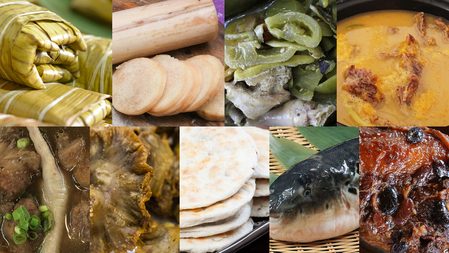

![[Ilonggo Notes] Putting the spotlight on Ilonggo and regional cinema](https://www.rappler.com/tachyon/2024/04/Screenshot-2024-04-07-at-2.04.59-PM.png?resize=257%2C257&crop=321px%2C0px%2C809px%2C809px)
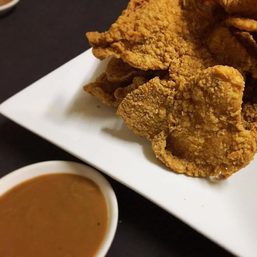
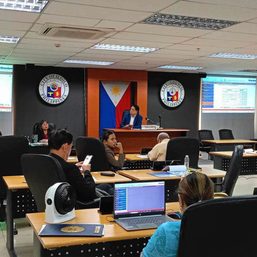

There are no comments yet. Add your comment to start the conversation.